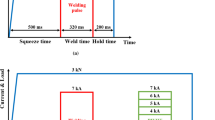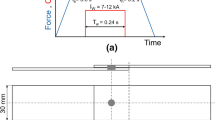Abstract
This study consisted of a comparative evaluation of the mechanical properties and failure behavior of QP980 steel with those of DP980 steel spot welds. Moreover, this paper contributes to the existing knowledge of the resistance spot welding behavior of QP steels by analyzing their microstructure, hardness profile, tensile shear strength, cross tension strength, and failure behavior. It was found that the cross tension and tensile shear test samples all failed in a partial or full button pull-out mode, with an acceptable ductility ratio and cross tension strength as per AWS. Fractography of the testing samples showed that the crack propagated along the fusion boundary, an occurrence previously reported in the literature for QP980, but with no comprehensive explanation regarding the mechanism behind the behavior. This work discusses the similarities between this behavior and welds exhibiting a possible softened region at the fusion boundary, a phenomenon known as the halo ring. The role of this softened region on the failure behavior of the welds is described.












Similar content being viewed by others
References
Act C, Act C, Facility DM et al (2020) The safer affordable fuel-efficient (SAFE) vehicles rule for model years 2021–2026 passenger cars and light trucks. Fed Regist 85:24174–25278
Wang L, Speer JG (2013) Quenching and partitioning steel heat treatment. Metallogr Microstruct Anal 2:268–281. https://doi.org/10.1007/s13632-013-0082-8
DiGiovanni C, Biro E, Zhou NY (2019) Impact of liquid metal embrittlement cracks on resistance spot weld static strength. Sci Technol Weld Join 24:218–224. https://doi.org/10.1080/13621718.2018.1518363
Wintjes E, DiGiovanni C, He L et al (2019) Quantifying the link between crack distribution and resistance spot weld strength reduction in liquid metal embrittlement susceptible steels. Weld World 63:807–814. https://doi.org/10.1007/s40194-019-00712-5
He L, DiGiovanni C, Han X et al (2019) Suppression of liquid metal embrittlement in resistance spot welding of TRIP steel. Sci Technol Weld Join 24:579–586. https://doi.org/10.1080/13621718.2019.1573011
Speer JG, De Moor E, Findley KO et al (2011) Analysis of microstructure evolution in quenching and partitioning automotive sheet steel. Metall Mater Trans A Phys Metall Mater Sci 42:3591–3601. https://doi.org/10.1007/s11661-011-0869-7
Fonstein N (2015) Advanced high strength sheet steels
Speer JG, De Cooman BC, Matlock DK, Schroth JD (2003) Carbon partitioning into austenite after martensitic transformation. Acta Mater 51:2611–2622
Edmonds DV, He K, Rizzo FC et al (2006) Quenching and partitioning martensite-a novel steel heat treatment. Mater Sci Eng A 438–440:25–34. https://doi.org/10.1016/j.msea.2006.02.133
Guo S, Peng Y, Zhu J et al (2018) Microstructure and mechanical properties of laser welded Ti/Al alloys. Zhongguo Jiguang/Chin J Lasers 45:229–238. https://doi.org/10.3788/CJL201845.1102010
Li W, Ma L, Peng P et al (2018) Microstructural evolution and deformation behavior of fiber laser welded QP980 steel joint. Mater Sci Eng A 717:124–133. https://doi.org/10.1016/j.msea.2018.01.050
Lin H, Jiang H, Wang Y, Tian S (2019) Microstructure gradient characteristics and mechanical properties of friction stir welded high strength QP980 steel. Mater Res Express 6:126584. https://doi.org/10.1088/2053-1591/ab5a92
Kim JW, Murugan SP, Yoo JH et al (2020) Enhancing nugget size and weldable current range of ultra-high-strength steel using multi-pulse resistance spot welding. Sci Technol Weld Join 25:235–242. https://doi.org/10.1080/13621718.2019.1680483
Kim JU, Murugan SP, Kim JS et al (2021) Liquid metal embrittlement during the resistance spot welding of galvannealed steels: synergy of liquid Zn, α-Fe(Zn) and tensile stress. Sci Technol Weld Join 26:196–204. https://doi.org/10.1080/13621718.2021.1880816
Fan CL, Ma BH, Chen DN et al (2016) Spall strength of resistance spot weld for QP steel. Chin Phys Lett 33:2–7. https://doi.org/10.1088/0256-307X/33/3/036201
Fan C, Ma B, Chen D et al (2019) Uniaxial compression properties of fusion zone martensite in resistance spot-weld for QP980 steel. Weld World 63:161–166. https://doi.org/10.1007/s40194-018-0646-y
Wang B, Duan QQ, Yao G et al (2014) Investigation on fatigue fracture behaviors of spot welded Q&P980 steel. Int J Fatigue 66:20–28. https://doi.org/10.1016/j.ijfatigue.2014.03.004
Lei M, Pan H (2012) Comparative study of resistance spot welding performance between cold-rolled DP980 and Q & P980 steels. Baosteel Technol Res 6:2–5
Liu XD, Xu YB, Misra RDK et al (2019) Mechanical properties in double pulse resistance spot welding of Q&P 980 steel. J Mater Process Technol 263:186–197. https://doi.org/10.1016/j.jmatprotec.2018.08.018
AWS (2012) AWS D8.9M:2012 test methods for evaluating the resistance spot welding behavior of automotive sheet steel materials. 1–106
Ramachandran DC, Kim SD, Moon J et al (2020) Classification of martensite-austenite constituents according to its internal morphology in high-strength low alloy steel. Mater Lett 278. https://doi.org/10.1016/j.matlet.2020.128422
Ramachandran DC, Moon J, Lee C-H et al (2021) Role of bainitic microstructures with M-A constituent on the toughness of an HSLA steel for seismic resistant structural applications. Mater Sci Eng A 801. https://doi.org/10.1016/j.msea.2020.140390
Frint P, Kaiser T, Mehner T et al (2019) Strain-rate sensitive ductility in a low-alloy carbon steel after quenching and partitioning treatment. Sci Rep 9:1–7. https://doi.org/10.1038/s41598-019-53303-1
Seo EJ, Cho L, Estrin Y, De Cooman BC (2016) Microstructure-mechanical properties relationships for quenching and partitioning (Q&P) processed steel. Acta Mater 113:124–139. https://doi.org/10.1016/j.actamat.2016.04.048
Arlazarov A, Ollat M, Masse JP, Bouzat M (2016) Influence of partitioning on mechanical behavior of Q&P steels. Mater Sci Eng A 661:79–86. https://doi.org/10.1016/j.msea.2016.02.071
GhateiKalashami A, Han X, Goodwin F, Zhou NY (2020) The influence of modified annealing during the galvanizing process on the resistance spot welding of the CMn1.8Si advanced high strength steel. Surf Coatings Technol 381. https://doi.org/10.1016/j.surfcoat.2019.125181
Ludwigson DC, Schwerer FC (1971) The effect of composition on the resistivity of carbon steel sheet. Metall Mater Trans B 2:3500–3501. https://doi.org/10.1007/BF02811640
Kaiser JG, Dunn GJ, Eagar TW (1982) Effect of electrical resistance on nugget formation during spot welding. Weld J (Miami, Fla) 61:167–174
Print T (1992) Introduction to the physical metallurgy of welding
THELNING K-E (1975) Alloying elements in steel
Blondeau R, Maynier P, Dollet J, Viellard-Baron B (1976) Mathematical model for the calculation of mechanical properties of low alloy steel products. London, Met Soc 189–200
Nayak SS, Baltazar Hernandez VH, Zhou Y (2011) Effect of chemistry on nonisothermal tempering and softening of dual-phase steels. Metall Mater Trans A Phys Metall Mater Sci 42:3242–3248. https://doi.org/10.1007/s11661-011-0868-8
Biro E, McDermid JR, Embury JD, Zhou Y (2010) Softening kinetics in the subcritical heat-affected zone of dual-phase steel welds. Metall Mater Trans A Phys Metall Mater Sci 41:2348–2356. https://doi.org/10.1007/s11661-010-0323-2
Saha DC, Nayak SS, Biro E et al (2014) Mechanism of secondary hardening in rapid tempering of dual-phase steel. Metall Mater Trans A Phys Metall Mater Sci 45:6153–6162. https://doi.org/10.1007/s11661-014-2591-8
Shome M, Tumuluru M (2015) Welding and joining of advanced high strength steels (AHSS). Weld Join Adv High Strength Steels 1–190. https://doi.org/10.1016/C2013-0-16259-9
Radakovic DJ, Tumuluru M (2012) An evaluation of the cross-tension test of resistance spot welds in high-strength dual-phase steels. Weld J 91
AWS (2007) AWS D8.1M:2007 Specification for automotive weld quality-resistance spot welding of steel
Sherepenko O, Kazemi O, Rosemann P et al (2020) Transient softening at the fusion boundary of resistance spot welds: a phase field simulation and experimental investigations for al–si-coated 22mnb5. Metals (Basel) 10. https://doi.org/10.3390/met10010010
Sherepenko O, Jüttner S (2019) Transient softening at the fusion boundary in resistance spot welded ultra-high strengths steel 22MnB5 and its impact on fracture processes. Weld World 63:151–159. https://doi.org/10.1007/s40194-018-0633-3
Mohamadizadeh A, Biro E, Worswick M (2020) Shear band formation at the fusion boundary and failure behaviour of resistance spot welds in ultra-high-strength hot-stamped steel. Sci Technol Weld Join 25:556–563. https://doi.org/10.1080/13621718.2020.1773057
Standard ASTM (2017) Standard test method for microindentation hardness of materials. ASTM Int E384:1–40. https://doi.org/10.1520/E0384-17
Funding
The authors would like to acknowledge the National Science and Engineering Research Council (NSERC) of Canada and ArcelorMittal Dofasco G.P. in Hamilton, Canada, for providing financial support and materials to carry out this work.
Author information
Authors and Affiliations
Corresponding author
Ethics declarations
Conflict of of interest
The authors declare no competing interests.
Additional information
Publisher's note
Springer Nature remains neutral with regard to jurisdictional claims in published maps and institutional affiliations.
Recommended for publication by Commission III - Resistance Welding, Solid State Welding, and Allied Joining Process
Rights and permissions
About this article
Cite this article
Figueredo, B., Ramachandran, D.C., Macwan, A. et al. Failure behavior and mechanical properties in the resistance spot welding of quenched and partitioned (Q&P) steels. Weld World 65, 2359–2369 (2021). https://doi.org/10.1007/s40194-021-01179-z
Received:
Accepted:
Published:
Issue Date:
DOI: https://doi.org/10.1007/s40194-021-01179-z




